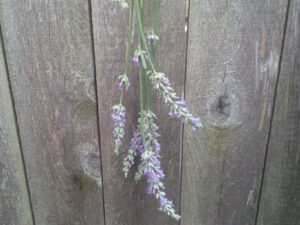 For millennia, the scent of lavender, botanically known as Lavendula, has been renowned for its ability to promote calm, consolation and even pain relief. For those reasons and many others, I grow this well-loved herb in my garden.
For millennia, the scent of lavender, botanically known as Lavendula, has been renowned for its ability to promote calm, consolation and even pain relief. For those reasons and many others, I grow this well-loved herb in my garden.
I don’t have a dedicated herb garden, but I am increasingly using lavender throughout my mixed borders. The plants produce a big flush of bloom in late spring, but if I shear the plants back in a timely fashion, many of them will throw out a few flower spikes through the end of the growing season. Sometimes that happens even if I forget to prune.
I should add that shearing lavender after it blooms is easy and can be done with shears or electric tools. And of course, you can always multi-task by harvesting blooming stalks to use in sachets, potpourris or other indoor applications. Tie or rubberband stalks and hang upside down in a well-ventilated location. The lavender should be dry and ready to use within a week.
Even when lavender is between bloom cycles, it beautifies its environment with lovely green, gray-green or blue-green foliage that is fragrant in its own right. Deer and four-legged garden predators do not like lavender. In my experience it is also somewhat of a deterrent to insect pests.
Like the roses with whom it frequently associates, lavender is a shrub. Delving into the realm of sub-classification, it is a “woody subshrub”, which means that it has shrubby or woody basal stems, but the top growth is non-woody and more like that of perennial plants. In the last few decades, another “woody subshrub”, aromatic Russian sage—Perovskia atriplicifolia—has grown increasingly popular. It is one of lavender’s closest botanical relations within the Labiatae or mint family. Rosmary or Rosmarinus is another close relative with a pervasive fragrance.
Many of my lavenders are well-loved older varieties, including traditional English lavender or Lavendula angustifolia like deep purple-flowered ‘Munstead’ and ‘Hidcote’ Generally these species/varieties like full sun, lean soil, excellent drainage and annual or semi-annual pruning. They do not like heavy clay soil and the perpetual “wet feet” that results from being situated in that kind of moisture-retentive soil. The best remedy for wet feet is to amend the soil with grit or fine gravel when planting lavender.
Conversely, lavender can tolerate drought, once it is established and generally does not need supplemental water. Mulching helps insulate the plants and protect the roots from extreme temperature variations.
As my love of lavender has grown, I have branched out into newer varieties. ‘Phenomenal’ is a variety of Lavendula x intermedia that is reputed to be more tolerant of both winter cold and hot, humid summers. My climate has both, so I have high hopes that ‘Phenomenal’ will live up to its name.
I am also intrigued by varieties with pink, white or lighter blue/purple flowers. As indicated by its name, ‘Edelweiss’ bears white flower spikes that have all the classic lavender characteristics, including spectacular fragrance. I just installed one near a yellow-flowered rose bush, and am eagerly awaiting the first season of bloom. ‘Flower kisser’ is a new variety of lavender with color-changing flowers. White buds and emerging blooms darken gradually over the season through lighter blue to a medium to dark shade. For pink flowers, the relatively new ‘Elegance Pink’ is a widely available choice with fray-green foliage.
Lavender can also be grown in containers, but needs fairly large containers to succeed well. If you have a container garden or limited space, look for varieties like Lavendula angustifolia ‘Thumbelina Leigh’, with blue-purple flowers and a maximum height of 15 inches. A mature plant should provide plenty of lovely blooms and quantities of fragrant dried lavender to improve indoor environments.
I think that lavender equals happiness overall. To add some of that happiness to your garden, try High Country Gardens, 6921 Pan American Hwy NE Albuquerque, CO 87109; (800) 925-9387; www.highcountrygardens.com.
